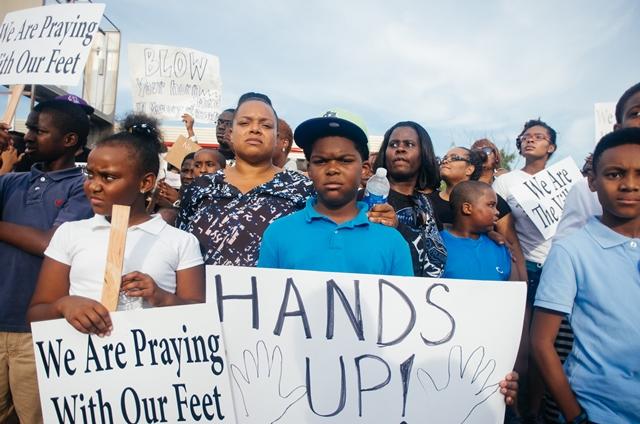Ferguson and its Shiny New Lawsuit
When the Justice Department decides to sue
by Jamelle Bouie via Wikipedia Commons
Protesters in multiple locations participated in “die-ins”. Each person would lay on the street inside an outline of chalk. They would do so for four minutes and thirty seconds, representing the four hours and thirty minutes that Michael Brown had spent lying dead on the street.
The autopsy unveiled a trail of bullet holes. It began from the right hand and led up to the top of the teenager’s head. The pathologist who conducted the autopsy, Dr. Michael Baden, did not discover a single trace of gunpowder residue. Officer Darren Wilson, the pathologist estimated, then could not have shot 18 year-old Michael Brown at a distance of less than two feet. The gun has to be close in order to leave gunpowder on its victim. Perhaps Brown was running away as officer Wilson was shooting at him. Brown would then be innocent since he was only fleeing in self-defense. However, another autopsy seemed to contradict this. The official county’s autopsy uncovered chemicals that are typically released from a gun’s barrel hidden inside of Michael Brown’s thumb. The presence of those chemicals may indicate that Brown instead lunged at officer Darren Wilson to engage in close hand-to-hand combat. Brown would then be the offender who aggressively pursued Wilson and forced Wilson to shoot out of a need to protect himself.
Regardless of the details, Michael Brown is dead and has been since August 9, 2014. But the effects of his death have continued to kindle various reactions. They include not only the protests – both in 2014 and 2015 – initiated by citizens but also the interventions being pursued by the national government.
Seven months after the incident, entering 2015, the U.S. Justice Department produced reports revolving around the shooting case. In the first report, to the disappointment of Brown’s supporters, the department could not find a reason to prosecute Wilson. On the other hand, in another report, the investigators scathed the Furgeson police with criticism. They found practices based on maximizing revenue, racist e-mails circulating amongst officials, and multiple cases of bias against African Americans. In response to those sins, the Department of Justice issued a document to Ferguson. The document required the city to reform its police training and administration in order for its officers to remain in duty.
The city council of Ferguson reviewed the document and what it entailed. The council did consent to the document’s requirements but not without a few changes. The projected cost of reforming the police department was $2.2 million to $3.7 million, a price beyond what the council was willing to pay for. So the council members voted to downsize the reform by cropping some of its contents. On February 9, 2016, the amended product was then submitted back to the Department of Justice for approval.
The department disapproved and sued. In less than 24 hours, Ferguson received a lawsuit for violation of civil rights. Attorney General Loretta E. Lynch said the city’s decision left her administration with “no further choice”. The federal government intends to deliver the constitutional rights of equality to the people of Ferguson.
But some of those residents are worried. As noted by a city local, Blake Ashby, the Justice Department may bring a “moral victory [for] many in the social justice movement” but it would also bring “an economic defeat” for Ferguson. In his view, human rights should be served but not at the expense of crippling an entire community.
Your donation will help support The Lambert Post, Lambert High Schools student-run newspaper! Your contribution will allow us to purchase equipment and cover website hosting costs.













